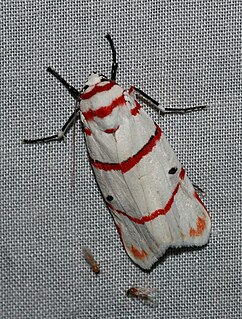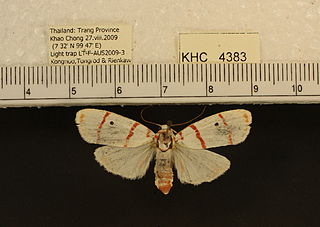
Cyana is a genus of moths in the family Erebidae. Species are well distributed in Africa, Madagascar, China, India, Sri Lanka, Myanmar, Sumatra, Java and Borneo. The genus was erected by Francis Walker in 1854.

Cyana malayensis is a moth of the family Erebidae. It is found in Peninsular Malaysia, Borneo and Palawan.

Cyana effracta is a moth of the family Erebidae. It is found in Nepal, north-eastern Himalaya, Taiwan, China, Burma, Peninsular Malaysia, Sumatra and Borneo.
Cyana amatura is a moth of the family Erebidae. It is found in Madagascar.
Brunia apicalis is a moth of the family Erebidae. It was described by Francis Walker in 1862. It is found on Borneo. The habitat consists of forests, ranging from lowlands to 1,200 meters.
Cyana delicata is a moth of the family Erebidae. It was described by Francis Walker in 1854. It is found in Angola, the Democratic Republic of the Congo, Ghana, Sierra Leone and Togo.

Cyana perornata is a moth of the family Erebidae. It was described by Francis Walker in 1854. It is found in India and Sundaland. The habitat consists of lowland forests, extending more weakly into lower montane forests.
Cyana rejecta is a moth of the family Erebidae. It was described by Francis Walker in 1854. It is found in the Democratic Republic of the Congo, Ethiopia, Kenya, Malawi, Sierra Leone, South Africa, Tanzania, Gambia and Uganda.
Lambula fuliginosa is a moth of the family Erebidae. It was described by Francis Walker in 1862. It is found on Borneo. The habitat consists of montane forests, dipterocarp forests and lowland forests.
Poliosia muricolor is a moth in the family Erebidae. It was described by Francis Walker in 1862. It is found on Borneo and in Singapore and India. The habitat consists of lowland forests.
Tampea reversa is a moth in the subfamily Arctiinae. It was described by Francis Walker in 1862. It is found on Borneo and Java. The habitat consists of lowland areas and lower montane forests.
Teulisna chiloides is a moth in the family Erebidae. It was described by Francis Walker in 1862. It is found on Peninsular Malaysia, Sumatra, Borneo, Sulawesi and Sumbawa. It has also been recorded from Queensland. The habitat consists of lowland dipterocarp forests, alluvial forests and lower montane forests.
Teulisna nebulosa is a moth in the family Erebidae. It was described by Francis Walker in 1862. It is found on Peninsular Malaysia and Borneo. The habitat consists of lower montane forests.
Teulisna plagiata is a moth in the family Erebidae. It was described by Francis Walker in 1862. It is found on Borneo. The habitat consists of lower montane forests.
Tigrioides leucanioides is a moth in the family Erebidae. It was described by Francis Walker in 1862. It is found in southern Myanmar and on Peninsular Malaysia, Sumatra and Borneo. The habitat consists of lower montane forests and lowland forests, including alluvial forests.
Trichaetoides separabilis is a moth in the family Erebidae. It was described by Francis Walker in 1862. It is found on Borneo. The habitat consists of lowland alluvial forests and dipterocarp forests.
Utetheisa abraxoides is a moth in the family Erebidae. It was described by Francis Walker in 1862. It is found on Borneo. The habitat consists of upper montane forests.
Ocinara albicollis is a moth in the Bombycidae family. It was described by Francis Walker in 1862. It is found in Kenya, China, Thailand, Malaysia, India, Sri Lanka and on Sumatra, Java and Borneo. The habitat consists of lower and upper montane forests, but it has also been recorded in the lowlands.
Cyana detrita is a moth of the family Erebidae. Male has a wingspan of 15mm and female with 19mm.
Cyana subornata is a moth of the family Erebidae first described by Francis Walker in 1854. It is found in India, Borneo and Sri Lanka.







